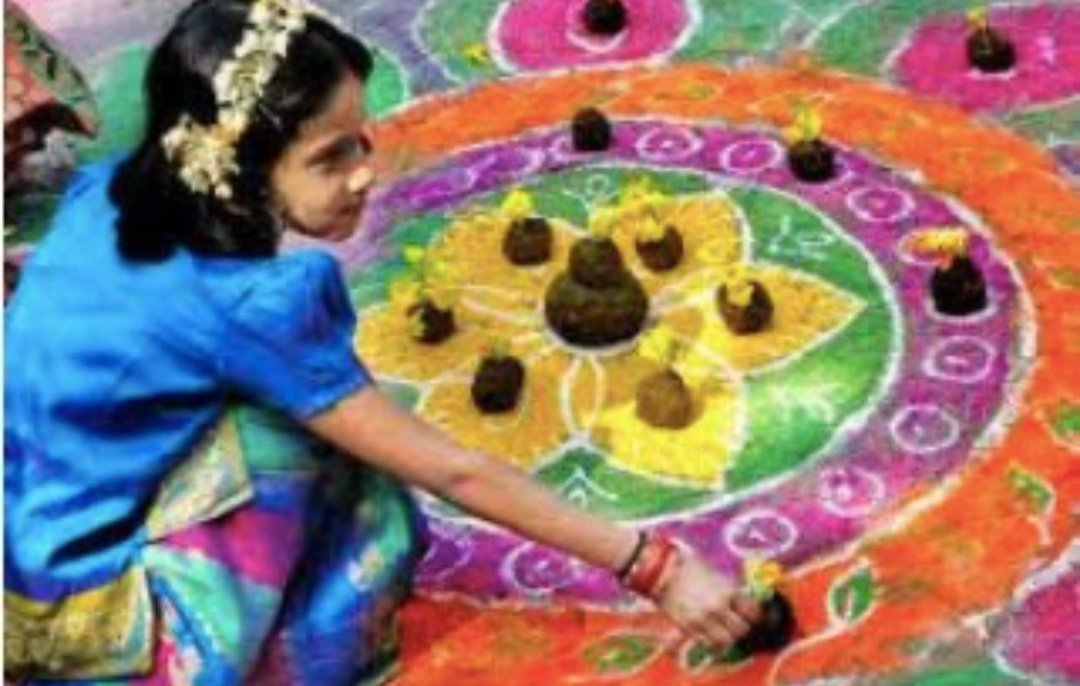
Bhogi- The Festival of Bonfire
The Pedda Pandaga - పెద్ద పండగ
Another Hindu festival whose rituals showcases that we are not only Culturally Unmatchable but also Scientifically Ingenious ;
‘Parama Pujaniya’ are our ancestors & elders who laid these for us.
#Thread
The Pedda Pandaga - పెద్ద పండగ
Another Hindu festival whose rituals showcases that we are not only Culturally Unmatchable but also Scientifically Ingenious ;
‘Parama Pujaniya’ are our ancestors & elders who laid these for us.
#Thread

Let's look at 3 important rituals associated with Bhogi Panduga :-
~ Bhogi Mantalu
~ Bhogi Pallu
~ Muggulu
Bhogi Mantalu :
Mantalu is the telugu word for Fire, On Bhogi day, early morning before sunrise, a bonfire is set in front of the house. This bonfire is called
~ Bhogi Mantalu
~ Bhogi Pallu
~ Muggulu
Bhogi Mantalu :
Mantalu is the telugu word for Fire, On Bhogi day, early morning before sunrise, a bonfire is set in front of the house. This bonfire is called

'Bhogi Mantalu' in Telugu. this is set either ndividually by each household or set at the community level. Dry Cow dung cakes, Cow ghee, Banyan, Peepal & Neem tree wood were used in Bonfire, This holy smoke will purify the environment by their medicinal properties. 

"Nearly 10grams of Cow ghee will release 1 ton of Oxygen" nto the air” ; by inhaling this air, the disease causing germs which are widely spread during the winter will be destroyed. This air will detox the body by cleansing 72,000 nerves. Scientifically this fire will raise our 

body temperature & kill diseases causing germs in the body. All the people will get health benefits with this bonfire !
Bhogi Muggulu :
Muggulu is the Telugu word for ‘floral designs on the floor’, they are special attraction and are done with intrinsic devotional & artistic
Bhogi Muggulu :
Muggulu is the Telugu word for ‘floral designs on the floor’, they are special attraction and are done with intrinsic devotional & artistic

way. It brings welfare to the family or home by eradicating the evil forces without attacking. It’s design has significance attached to it. The lines drawn are considered as the fear to evils that is why most of the Muggu’s have a design of star. A dot of rangoli has got 

capability of changing negative thoughts to positive thoughts.The rounded design of rangoli creates a positive energy in the humans bringing down their negative energy levels.
Muggullu usually attracts the first sight of a visitor to the home, so we draw complex designs of
Muggullu usually attracts the first sight of a visitor to the home, so we draw complex designs of

as it is usually and so the negative energies get struck in that complexity and fail entering the house.
People feel good before entering a house and exit good after leaving the house.
Bhogi Pallu :
Pallu or Phalalu is the telugu word for fruits
Bhogi Pallu is special ritual
People feel good before entering a house and exit good after leaving the house.
Bhogi Pallu :
Pallu or Phalalu is the telugu word for fruits
Bhogi Pallu is special ritual

where all fruits and coins are collected & showered on the heads of small children to protect them from negative forces.This ritual will bring happiness, good fortune & success.Mixture of Jujube or Indian date, gooseberries, small sugarcane pieces and rice are used in showering.
People believe that Indian date is the favourite fruit for Lord Lakshmi Narayana. By showering these fruits on heads will acquire blessings of the god.
~ ~ ~
Celebrate Preserve & Pass on to next generation ; tell your kids & the young how
~ ~ ~
Celebrate Preserve & Pass on to next generation ; tell your kids & the young how
great we are culturally & scientifically. Nothing comes close to our Hindu festivals & rituals.
Tell them the inferiority complex in them is cultivated by westerners & their Distorians for they can neither digest nor achieve our Superiority!
Tell them to celebrate with Pride!🙏
Tell them the inferiority complex in them is cultivated by westerners & their Distorians for they can neither digest nor achieve our Superiority!
Tell them to celebrate with Pride!🙏

@RituRathaur @ikkmurugan @Mishti_in @shallakaul @BeenaPP1 @IshaSattva @GeetaRaavi @ArmyKaFan @Kachnarr @apparrnnaa @UshaNirmala @LokaGatha @BangadVedant @Aneelgs @PreciselyPriya @MadhvaHistory @VamseeJuluri
"unroll"
"unroll" @threadreaderapp
• • •
Missing some Tweet in this thread? You can try to
force a refresh



















